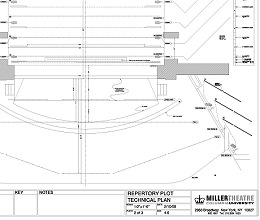
If good luck in travel is a harbinger of things to come, then the fact that my flight into Kansas City for the Second International Conference on Minimalist Music actually touched down twenty minutes early is surely a very good sign. And so far today things have worked out that way.
The conference got underway with two papers on Intertextuality in the music of Dutch composer Louis Andriessen and British composer (and the first journalist to use the word “minimalist” to describe music) Michael Nyman. Apparently Nyman steals liberally from everybody, including himself. I mean that in only the best possible way–Nyman seems to deeply interested in the artistic possibilities that such borrowing and referencing, and he even once had a microfilm reader in his house next to his piano to enhance his ability to quickly look for material to work with. After a short break we then had three papers on the music of Phill Niblock, whose microtonal drone music is strange, fascinating, and beautiful.
After dinner, and after an on-stage conversation with Kyle Gann, Mikel Rouse presented his 2000 film Funding at the Kansas City Public Library. The film is a fascinating non-narrative (or perhaps extremely-limited-narrative) exploration of New York City, money, and identity, underscored by Rouse’s post-minimalist, rhythmically complex music. Rouse has clips of some of his films, including Funding, on his website, so I’ll just direct you there, since I need to get some sleep so I’ll be fresh for day two, which starts at 9AM tomorrow with a paper on Steve Reich.
Also, remember that some of the conference participants are Twittering about the conference with the hashtag #minconf.
 Up and running for a few weeks now,
Up and running for a few weeks now, 


 Our pal
Our pal  In celebration of Louis Andriessen’s seventieth birthday, the first UK performance of his The Hague Hacking was scheduled for the Prom concert on August 17. The piece was commissioned by the Los Angeles Philharmonic and first performed with that orchestra by the pianists Katia and Marielle Labèque and Esa-Pekka Salonen, who were the performers for the Proms, playing this time with the Philharmonia Orchestra. There were several sources, or perhaps references embedded in The Hague Hacking: the piano parts make use at the beginning and subsequently in the piece of the notes of the beginning of the Lizst Hungarian Rhapsody No. 2, which Andriessen knew not so much from knowing the piece itself as from knowing its use in a Tom and Jerry cartoon, The Cat Concerto (Warner Brothers used the Lizst in a similar way in a fairly well known Bugs Bunny cartoon, Rhapsody Rabbitt); the work also uses a Dutch “sing-along ballad” about The Hague, O, O, The Hague (Andriessen suggested in an interview that the text of this song is vulgar), whose notes are presented first at lengths which render it unrecognizable, but on subsequent reappearances faster, finally, apparently, at the end of the work, at its original speed; in addition the work’s Dutch title, Haags Hakkûh, makes allusion to the slang name (the second word of the title) for what we are told in Robert Adlington’s program note is a “a distinctive kind of dance, characterized by quick ‘chopping’ foot movements, that emerged in Dutch nightclubs in the 1990’s.
In celebration of Louis Andriessen’s seventieth birthday, the first UK performance of his The Hague Hacking was scheduled for the Prom concert on August 17. The piece was commissioned by the Los Angeles Philharmonic and first performed with that orchestra by the pianists Katia and Marielle Labèque and Esa-Pekka Salonen, who were the performers for the Proms, playing this time with the Philharmonia Orchestra. There were several sources, or perhaps references embedded in The Hague Hacking: the piano parts make use at the beginning and subsequently in the piece of the notes of the beginning of the Lizst Hungarian Rhapsody No. 2, which Andriessen knew not so much from knowing the piece itself as from knowing its use in a Tom and Jerry cartoon, The Cat Concerto (Warner Brothers used the Lizst in a similar way in a fairly well known Bugs Bunny cartoon, Rhapsody Rabbitt); the work also uses a Dutch “sing-along ballad” about The Hague, O, O, The Hague (Andriessen suggested in an interview that the text of this song is vulgar), whose notes are presented first at lengths which render it unrecognizable, but on subsequent reappearances faster, finally, apparently, at the end of the work, at its original speed; in addition the work’s Dutch title, Haags Hakkûh, makes allusion to the slang name (the second word of the title) for what we are told in Robert Adlington’s program note is a “a distinctive kind of dance, characterized by quick ‘chopping’ foot movements, that emerged in Dutch nightclubs in the 1990’s.

